What Is Harp Therapy
Funny how much more you can say with a few bars of music than with a basket full of words.
Rick Blaine (Humphrey Bogart) in Casablanca
Playing the harp at the bedside is a form of harp therapy, a general term used to describe the continuum of types of therapies in which the harp is used. Taking harp lessons is at the active end, while experiencing live harp music is on the passive end of that continuum. Bedside Harp® offers a full array of programs involving each of these types of therapies.
The harpist playing at the bedside offers the recipient comfort, release of emotions and relaxation wherever that recipient may be — in a chair, in bed, on a gurney, in a hospital room, in a hallway, or in waiting areas. The recipient need do nothing but relax into the gentle sounds of the little therapy harp. To experience it is to understand why so many people love it and so immediately respond to it.
Certified Harp Therapists and Certified Masters of Harp Therapy understand the truly awesome power of music, most especially, of harp music. They earned their certifications after many long hours of classroom studies and even more hours working long, highly structured, and closely supervised internships in medical settings. Their journeys to become Certified Harp Therapists and/or Certified Masters of Harp Therapy are intense, transforming and enlightening.
Taking harp lessons for the first time has its own benefits. Some of our adult students play for the joy of it, some to relieve stress, some to ease pain, some to overcome physical, mental and emotional challenges. Whatever the initial motivation, the student of folk harp reaps many benefits from this pursuit including relaxation, empowerment and a connection to a new community.
What is it about a harp that makes it the ideal instrument of healing? One of the earliest instruments made and played by humans, the harp at once evokes thoughts of days of old, the bible, angels, bliss, even heaven. The recipient of harp therapy is usually immediately taken with the very sight of the instrument. Fairly immediate too is the recipient’s response to the sound of the instrument’s exposed strings which vibrate freely as they offer deeply penetrating soothing and comfort. Patients have commented that the sound of the harp played at the bedside feels like a massage for the soul.
There is much about the harp to enthrall the first-time student. For starters, there is the positioning of the instrument in relation to the body of the player. Indeed, to play this wonderfully resonating instrument, the harpist must embrace it so that it rests upon his/her chest. The harpist then plucks each string with their bare finger — a sensory event that must be experienced to be fully appreciated. Add to all of this the pleasant, and we believe healing, physical sensation of the resulting vibrations felt immediately by the player, and one can begin to understand the allure and wonder of this ancient instrument.
And of course, the harp’s timbre — the soothing, gentle tones for which the instrument is so well loved — makes it apparent why our instrument is so often referred to not just as a harp, but rather, as a healing harp. Bedside Harp® beginner instructional students play their first pieces in the keys of either C or A minor, and so, once the harp has been brought into tune, all of the sounds produced are pleasing right from the start. Having taught the piano for over 35 years to children and adults, Edie attests to the fact that it takes far longer for beginner piano students to feel satisfied with the sounds they are able to make on that instrument than it does beginner harp students with the sounds they are able to make on the folk harp.
We suspect that there is yet another explanation for the high degree of healing we offer as we play our little harps for patients. Having closely followed the exhaustive research of Dr. Herbert Benson, Director Emeritus of the Benson-Henry Mind Body Institute in Boston, MA, we believe that the profound physiological, emotional and psychological results that we are privileged to bear witness to, are, in large part, attributable to what Benson calls the “relaxation response” which we believe we evoke as we play our little harps for patients, their families and staff. Some years ago Edie mentioned this to Dr. Benson and he heartily agreed.
From our inception, we have been very clear about the quality of harp that our harp therapist interns and graduate professionals play. For one thing, the harp had to have a rich, round sound. It also had to be well crafted and had to be highly portable. After all, if we view the harp as an instrument of healing, the harp we use and recommend has to deliver on all counts. And so, from 2002 to 2006, when Ansel Erickson-Zinter stopped making them, the Westover Therapy Harp was our harp of choice. Suddenly we found ourselves in somewhat of a quandary. What small, portable, well made harp would now satisfy our requirements for a good sound? Right around this time, Edie met and came to know Dwight Blevins, of Blevins Instruments. Dwight, who has been making quality harps for about twenty years, was open to developing a new instrument which would satisfy all the items on Edie’s wish list. What came out of their successful collaboration was the exquisite Marie Therapy Harps which, we are proud to say, has been the official harps of all of our programs since 2006. Click here to take a look at this rather extraordinary instrument.
